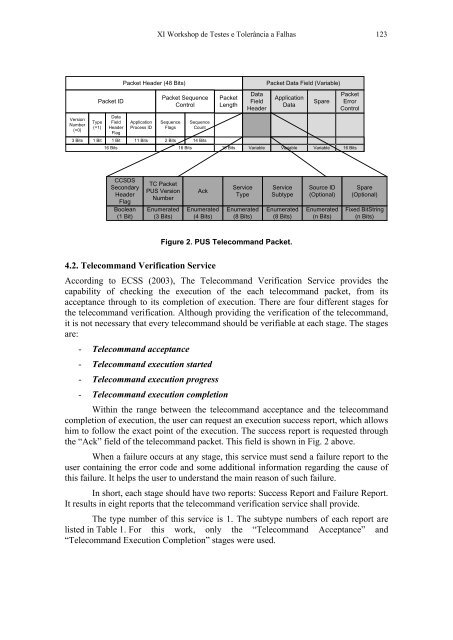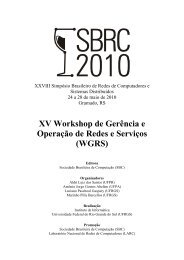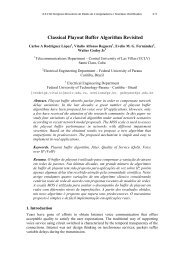XI Workshop de Testes e Tolerância a Falhas (WTF) - SBRC 2010
XI Workshop de Testes e Tolerância a Falhas (WTF) - SBRC 2010
XI Workshop de Testes e Tolerância a Falhas (WTF) - SBRC 2010
Create successful ePaper yourself
Turn your PDF publications into a flip-book with our unique Google optimized e-Paper software.
<strong>XI</strong> <strong>Workshop</strong> <strong>de</strong> <strong>Testes</strong> e Tolerância a <strong>Falhas</strong> 123<br />
Version<br />
Number<br />
(=0)<br />
Type<br />
(=1)<br />
Packet ID<br />
Data<br />
Field<br />
Hea<strong>de</strong>r<br />
Flag<br />
Packet Hea<strong>de</strong>r (48 Bits)<br />
Application<br />
Process ID<br />
Packet Sequence<br />
Control<br />
Sequence<br />
Flags<br />
Sequence<br />
Count<br />
3 Bits 1 Bit 1 Bit 11 Bits 2 Bits 14 Bits<br />
Packet<br />
Length<br />
16 Bits 16 Bits 16 Bits<br />
Data<br />
Field<br />
Hea<strong>de</strong>r<br />
Variable<br />
Packet Data Field (Variable)<br />
Application<br />
Data<br />
Variable<br />
Spare<br />
Variable<br />
Packet<br />
Error<br />
Control<br />
16 Bits<br />
CCSDS<br />
Secondary<br />
Hea<strong>de</strong>r<br />
Flag<br />
Boolean<br />
(1 Bit)<br />
TC Packet<br />
PUS Version<br />
Number<br />
Enumerated<br />
(3 Bits)<br />
Ack<br />
Enumerated<br />
(4 Bits)<br />
Service<br />
Type<br />
Enumerated<br />
(8 Bits)<br />
Service<br />
Subtype<br />
Enumerated<br />
(8 Bits)<br />
Source ID<br />
(Optional)<br />
Enumerated<br />
(n Bits)<br />
Spare<br />
(Optional)<br />
Fixed BitString<br />
(n Bits)<br />
Figure 2. PUS Telecommand Packet.<br />
4.2. Telecommand Verification Service<br />
According to ECSS (2003), The Telecommand Verification Service provi<strong>de</strong>s the<br />
capability of checking the execution of the each telecommand packet, from its<br />
acceptance through to its completion of execution. There are four different stages for<br />
the telecommand verification. Although providing the verification of the telecommand,<br />
it is not necessary that every telecommand should be verifiable at each stage. The stages<br />
are:<br />
- Telecommand acceptance<br />
- Telecommand execution started<br />
- Telecommand execution progress<br />
- Telecommand execution completion<br />
Within the range between the telecommand acceptance and the telecommand<br />
completion of execution, the user can request an execution success report, which allows<br />
him to follow the exact point of the execution. The success report is requested through<br />
the “Ack” field of the telecommand packet. This field is shown in Fig. 2 above.<br />
When a failure occurs at any stage, this service must send a failure report to the<br />
user containing the error co<strong>de</strong> and some additional information regarding the cause of<br />
this failure. It helps the user to un<strong>de</strong>rstand the main reason of such failure.<br />
In short, each stage should have two reports: Success Report and Failure Report.<br />
It results in eight reports that the telecommand verification service shall provi<strong>de</strong>.<br />
The type number of this service is 1. The subtype numbers of each report are<br />
listed in Table 1. For this work, only the “Telecommand Acceptance” and<br />
“Telecommand Execution Completion” stages were used.







